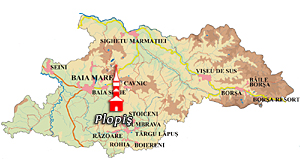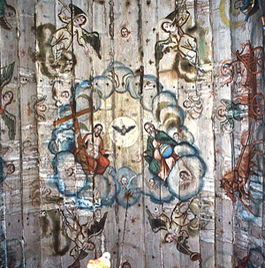Plopis Church

Year built: between 1796 and 1798
Location: Plopiş village is situated in the valley of the River Cavnic.
Summary: The walls of thick square-cut oak beams stand on a low foundation made of big blocks of stone. The technique of execution, the harmonious proportions, the carved and painted decoration, and the setting in the village environment justified the inclusion of the church on the World Heritage List.

The plan of the church is the usual one, rectangular, with a pentagonal chancel apse. There is a porch in front of the entrance on the west façade, six solid pillars supporting the beams that bear the weight of the roof. Half-circular arches join the pillars.
The tower above the pronaos has a balcony with 16 pillars and arches. On the corners of the tower roof there are four small-sized decorative pinnacles.
The church windows are very small, but they are arranged in pairs, a smaller one above a slightly bigger one. The upper frame of the windows is shaped in an elegant pointed tented arch.
The pronaos is very dark, with only a pair of windows, while there are eight windows in the naos and six in the chancel. The floors are made of big stone slabs.

The paintings were made in 1811 by Ştefan of Şişeşti, as shown by an inscription on an icon, but they are preserved only on the vaults of the naos and the chancel and on the iconostasis. The vault of the naos has a three-lobed section, with a main vault and side vaults on both sides. This is a unique structure among the wooden churches.
The central vault has in the middle a representation of The Holy Trinity, with the Virgin Mary at the east end. The side vaults have scenes from The Life and Passions of Christ.

The same painter also collaborated in the preparation of the paintings of the church in the neighbouring village – Şurdeşti. The church in Plopiş can be considered the younger sister of the church of Şurdeşti. Similarities include not only the style of painting, but also some architectural elements, such as the tall bell tower with four corner pinnacles, and certain sculpted decorations on the façades and incisions on the balustrades. But, there are several features that differentiate this church from others in the area: the double rows of windows, and the triple vaults of the naos that result from the fact that the walls do not taper slightly inward, as in most other churches.





 Travel Maramures
Travel Maramures Maramures Wooden Churches
Maramures Wooden Churches Maramures Traditions
Maramures Traditions Maramures Festivals
Maramures Festivals


